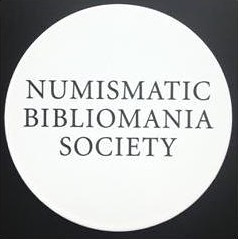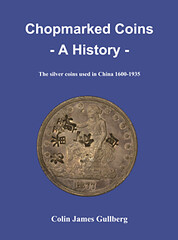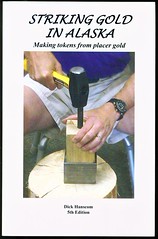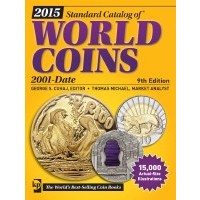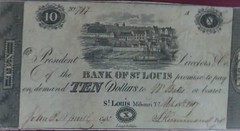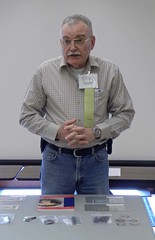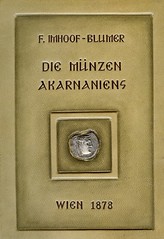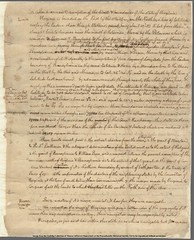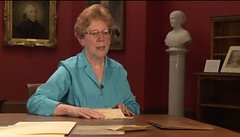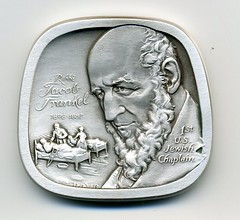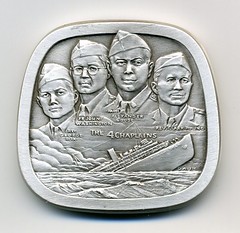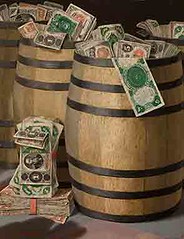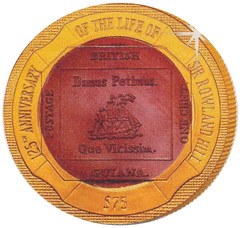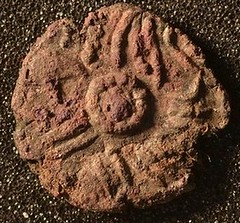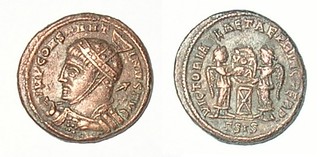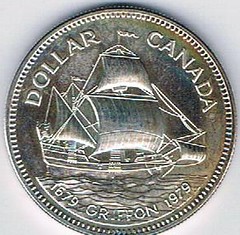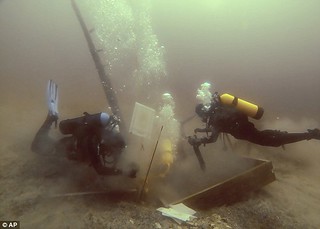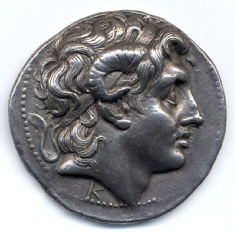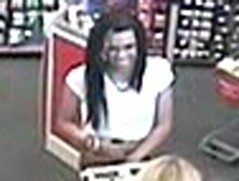
Volume 17, Number 27, June 29, 2014
Click here to read this issue on the web
Click here to access the complete archive To comment or submit articles, reply to whomren@gmail.com WAYNE'S WORDS: THE E-SYLUM JUNE 29, 2014
Our new subscribers this week include Chris Wise, Carol Fink and Harold Roberts. Welcome aboard! We have 1,739 email subscribers. We'd also like to welcome new advertiser Classical Numismatics Group, who are also supporting the NBS web site with a new ad on the home page. Be sure to thank and patronize all of our advertisers for their NBS and E-Sylum support. Fred Lake is among that group - Lake Books is a regular supporter, making a contribution in lieu of ads. This week we open with an update on NBS events at the upcoming Chicago ANA, three new books, and a tour of the Newman Money Museum. Other topics include Lao coins and currency, the Medallic Art Company archives, Congressional Gold medals, and the debate over collecting and cultural looting. Confucius say, "time fly, so mind your business." To learn more about chopmarked coins, the Lee Kim Guan coin shop, the Demonic Typo, Queen Victoria's Diamond Jubilee, the Four Chaplains, Schuler coin presses, the Portable Antiquities Scheme and the Poodle From Hell on stilts, read on. Have a great week, everyone!
Wayne Homren
NBS EVENTS AT THE 2014 CHICAGO ANA
Numismatic Bibliomania Society president Marc Ricard forwarded the following announcement about the speakers for the NBS symposium at the 2014 Chicago World's Fair of Money in Rosemont, Ill.
-Editor
The annual Symposium of the Numismatic Bibliomania Society (NBS) will feature the presentation What it Takes to Get your Numismatic Book or Article in Print: HOW TO RESEARCH, WRITE, AND HAVE IT PUBLISHED by distinguished NBS members, Q. David Bowers and Dennis Tucker. This NBS event will be held on Thursday, Aug. 7, from 11:30 a.m.-1 p.m. in Room 42 of the Donald E. Stephens Convention Center in Rosemont, Illinois, as part of the American Numismatic Association’s “World’s Fair of Money.” A question and answer session will follow immediately. The NBS Symposium is open to all ANA convention goers. Attendees will learn the keys to producing successful books and articles from two noted experts. As publisher at Whitman Publishing LLC, Dennis Tucker is the gatekeeper for incoming manuscripts and ideas for the world’s largest numismatic publisher. A leading hobby booster for 80 years, Whitman Publishing has put millions of books, supplies, folders, and albums in the hands of new collectors, young and old, in addition to publishing many books for more advanced numismatists. Q. David Bowers is author of more than 50 award winning numismatic books, hundreds of articles and is a noted rare coin dealer, currently Chairman Emeritus of Stack’s Bowers, of Irvine, California; New York City; Wolfeboro, NH; Paris and Hong Kong. Both Bowers and Tucker are longtime Numismatic Bibliomania Society members. The Numismatic Bibliomania Society (NBS) is an educational organization of nearly four hundred members founded in 1979 to support and promote the use and collecting of numismatic literature. For more information on how to join the NBS, write to NBS, P.O.Box 82, Littleton, NH 03561-0082, or visit the web link www.coinbooks.org/about/membership.html
Below is the full schedule reported to date.
-Editor
Numismatic Bibliomania Society's Symposium
Numismatic Bibliomania Society Board Meeting
Friday, Aug. 8
Numismatic Bibliomania Society General Meeting
For more information, see:
Get ready for the 2014 World's Fair of Money
(http://worldsfairofmoney.com/)
TOKEN, MEDAL AND POLITICAL AUCTION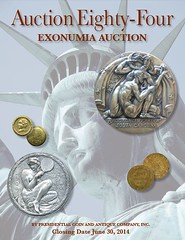
Presidential Coin & Antique Co., Inc.'s Auction Eighty-Four of Tokens, Medals and Political items closes June 30, 2014. Hardcopies $6 - contact Joe Levine at Jlevine968@aol.com or view the catalog online here . Hard Times Tokens, 19th Century Storecard Tokens, Civil War Tokens, Military & Related, So-Called Dollars, Presidential & Political, World's Fairs & Expositions, U.S. Mint Medals, ANS Medals, Foreign Tokens and Medals, and MORE! NEW BOOK: CHOPMARKED COINS - A HISTORY
Colin Guilberg of the Chopmark Collectors Club (CCC) forwarded this press release for his new book on chopmarked coins. Congratulations!
-Editor
CCC Member Price: $40 (plus S&H) includes Free e-newsletter for one year (a $10 value) Early Bird Special Price: $30 (plus $5 S&H) – Must be prepaid by July 20, 2014 (pick up available at the ANA World’s Fair of Money in Chicago Aug 7 & 8). It’s finally finished! My book, Chopmarked Coins – A History, will be printed by early July in Shanghai and will be ready for shipping in mid-July. The book covers the history of foreign silver coins in China during the period of 1600-1935 and contains high quality photos of over 150 coins. As there are few written records regarding the chops I focus on what information we do know, including first person accounts in other sources, summaries of all the modern sources of knowledge in the area and, most exciting, scans from a shroff’s handbook (circa 1890). If you would like to have one (or more) of these books it’s best to order now. I am giving a limited-time special price of $30 (plus $5 S&H) only for CCC members until July 20. As I will be hand carrying the books to the Chicago ANA World’s Fair of Money Show in August I must have your payment before I depart. I will mail the books from Chicago (media rate postage). Anyone picking up the book at the show will pay $30 only. This will include a free one year e-subscription to the Chopmark News (which will be going to $10/year effective 2014). If you live outside the US please contact me for shipping costs from Taiwan. The price quoted is net of bank charges so if you pay by PayPal (address: chopmarknews@gmail.com ) please add 5%. You can also pay by check to Rich Licato at:
Rich Licato
Please indicate if you would like me to autograph the book and/or write a dedication. The total print run will be 500 copies. By the way, the price will not cover the cost of printing the book – a loss which is being absorbed by Michael Chou.
ANA World’s Fair of Money This is the first time that I will be speaking to the general public and I am hopeful that the CCC will be able to pick up a few new members (I will be giving away free e-editions to the newsletter for those in attendance). I am hoping to hold a meeting of the CCC for any members in attendance at the show, either before or after my talk. Unfortunately, the convention center does not have a restaurant so we’ll have to think of another option. Nevertheless, it will be a good time for us to meet each other and talk about our favorite subject – chopmarked coins! Minutes after receiving Colin's announcement Howard Daniel write: I just ordered my copy. Colin adds: I can let E-Sylum readers who are not CCC members have the book at the show for the $30 price, but CCC members get first crack at buying the book (I'll be carrying a limited number of copies). Just mention that you saw the book in The E-Sylum to get the $30 price. Other non-members would pay $40. Note that you won't get a free e-membership; only current members will get their e-newsletter extended by a year. To read the complete ANA show schedule, see: http://worldsfairofmoney.com/schedule.aspx NEW BOOK: STRIKING GOLD IN ALASKA, 5TH EDITION
Dick Hanscom forwarded this press release for the new edition of his great little book on striking gold tokens.
-Editor
This 190 page paper bound book (8½ by 5½ inches) is fully illustrated in black and white with color covers. It follows the process from purchasing placer gold, preparing the gold for striking, engraving the dies and striking. Formulas are given for fluxes, specific gravity and determining the size of the tokens. There is also information on striking silver. Sources of supplies and equipment are listed. New techniques and projects are included. Bimetal tokens are made. A drop hammer is built. Updated mintages on all his tokens are given. There is information on Flussgolddukaten - German gold coins made from gold mined from rivers, not unlike what Dick is doing with gold from Alaska’s creeks. Most of the new information is related to the new gold tokens that have been made in the last year. Since the publication of the 4th edition, he has been fortunate to purchase gold from many new sources. Much information from U.S.G.S. bulletins is included about the sources of the gold. The price is $18, postpaid from: Alaska Rare Coins, P.O. Box 72832, Fairbanks, AK 99707
Dick's book gets better and better with each edition. I've got a copy of the latest. It's greatly expended and well-illustrated. A very interesting read for anyone interested in the tools and techniques of striking coins.
-Editor
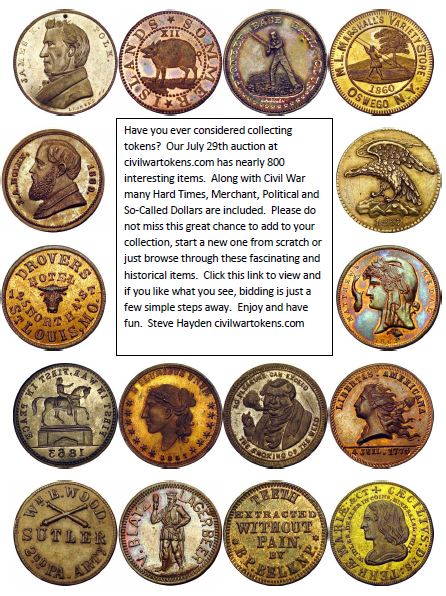
NEW BOOK: 2015 CATALOG OF WORLD COINS 2001 - DATE
Krause Publications has released a new edition of the Standard Catalog of World Coins 2001 - Date.
-Editor
The Standard Catalog of World Coins, 2001-Date is a leading authority in world coin prices and referencing. The 9th edition of this series is complete with updated information on all known 21st century coins. Whether you are a beginner or an expert in coins, this tool will cover the needs for any coin collector, dealer or enthusiast. All modern commemorative precious metal coins in the world are included in this edition. In the updated guide, you'll find:
George S. Cuhaj has been on the editorial staff of the Standard Catalog of World Paper Money and the Standard Catalog of World Coins for nearly 20 years. He is lead editor for the online product NumisMaster, cataloging new issues. Cuhaj also is the lead editor on the Standard Catalog of United States Paper Money and Canadian Coin Digest, among others. He was formerly a cataloger for the American Numismatic Society and Stack's Rare Coins, both of New York City.
For more information, or to order, see:
2015 Standard Catalog of World Coins 2001-Date, 9th Edition
(www.shopnumismaster.com/2015-standard-catalog-of NEWS CREW VISITS NEWMAN MONEY MUSEUM
This article and accompanying video is from the local St. Louis Fox affiliate, which recently visited the Newman Money Museum and interviewed curator Tom Serfass
-Editor
Tom Serfass/Curator Newman Money Museum: “It would have been what you would have seen from the river. A very small town. Indeed.” And its Tom Serfass’s job to make sure the story of this river town and the ten dollar bill it’s on are passed along to the public. Mr. Newman just turned 103 and his lifelong passion has been collecting coins. St. Louis’ Eric P. Newman has been a numismatic his whole life and donated a portion of his currency collection to Washington University, where he got his law degree in 1935.

The valuation is not nearly as important as the history it represents and the stories it can tell. This collection in the basement of the Kemper Art Museum has a potpourri of pocket change through the ages. So this is the continental currency dollar of 1776 and it’s the first great expression of we are our own country. On the front is Benjamin Franklin`s motto time fly, so mind your business, and the back carries the colonies message that we are one. But every dollar has a doozie of a story in this museum.
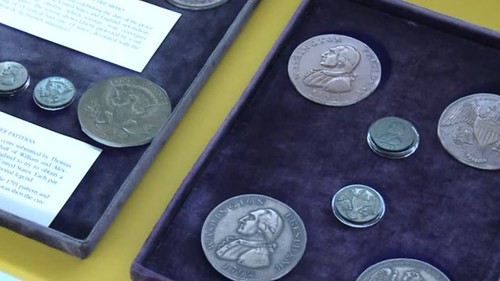
Benjamin Franklin was a big fan of putting sayings on coinages to improve the morals of the people. So this would be a reminding to not laze around and waste your time. There`s currency from our neighbors to the north and even some Missouri money to tell this region’s history. So even if you travel from say Pennsylvania to Missouri you would change your money much as you used to do in Europe. Who knew that a basement could hold so much national and local history that counts?
Yes, it says " Eric P. Newman has been a numismatic his whole life"
*Sigh*
-Editor
To read the complete article (or watch the video), see: Who knew coins could be worth millions (fox2now.com/2014/06/23/who-knew-coins-could-be-worth-millions/) HOWARD DANIEL ON LAO COINS AND BANKNOTES
Howard Daniel spoke at the recent Pacific Northwest Numismatic Association (PNNA) Convention about his latest book, Lao Coins & Currency. An accompanying article was published in the PNNA’s publication, The Nor’wester. With permission, here's an excerpt from his article.
-Editor
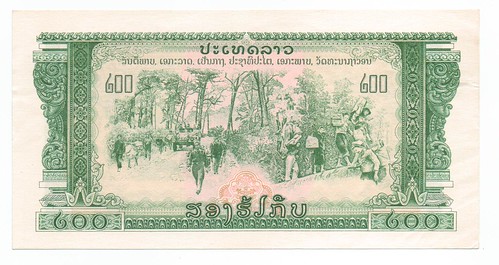
1968 Pathet Lao CIA Propaganda leaflet My interest in Lao began in 1964 when I was in the Army and stationed on Okinawa. An Air Force NCO, John Novak, talked me into collecting and writing about Southeast Asia numismatics. It took him awhile to convince me but I quickly dug into the area and disposed of my US coins and paper money. I was stationed in Southeast Asia from January 1966 to August 1970, and again in December 1971 to January 1973. I worked mostly within several intelligence activities and my backup site was in the JUSMAG Compound in Bangkok. Most of my numismatic time during those years was in Bangkok. I was very lucky to find the Lee Kim Guan shop in that city. It sold numismatic and philatelic pieces, and some catalogs. The first few times I was in the shop they could see from my haircut, I was just a GI on R&R and not a serious numismatist. Eventually, they did consider me a serious collector and researcher. At that time, they had often hundreds of particular pieces for sale and I could go through bags of coins and stacks of notes looking for pieces to add to my research collection. As the years have gone by to today, the stacks and bags are gone and most pieces available are singles to only two or three of a piece.
I sorted down the pieces into each country and started cataloging them. When I saw that I had enough pieces and information in a particular series, I started writing for the numismatic press and club and society journals. Then I started writing my catalogs. My Lao Coins & Currency catalog is my seventh catalog and I am now working on my eighth, which is the second edition of my Democratic Republic of Viet Nam Coins & Currency. It will be followed by the second edition of my Republic of Viet Nam Coins & Currency catalog. I am now publishing one catalog per year. If you ever come across a Lao piece that you want identified and/or authenticated, please send a photocopy to me at P.O. Box 626, Dunn Loring, VA 22027 or a scan at HADaniel3@msn.com. Never send the piece to me unless I request it. To read the complete issue, see: The Nor'Wester Third Quarter 2014 July-August-September (www.pnna.org/news/pdf/PNNAnews2014_Q3.pdf)
THE BOOK BAZARRENOTES FROM E-SYLUM READERS: JUNE 29, 2014Moulton Email Hacked Karl Moulton ( numiscats@aol.com ) writes: Last weekend, my AOL account was hacked. Emails from scammers were sent asking for money regarding a sick cousin in Portugal. Please do not reply to anything along those lines. It wasn't me. Thank you! Demonic Typo Chip Howell and other readers caught a typo in Dick Johnson's 'Calls to Arms' article last week. It should, of course, be 'demonetization', not 'demonization'. Sorry I missed that one. Ron Haller-Williams writes: Use of a capital M in "The ANA should lead the way to curtail the Electronic Transfer of Payment Monster" had my imagination running wild at the thought of some sort of a Payment Monster saying "Beam me up, Scottie"! More significantly, either auto-correct was on or you (or Dick?) were thinking rather too much about monsters, when talking about "commemorative 'coins' for sale to a gullible public. If they bore a demonization it would be meaningless because they could not be spent." I just love the thought association: denomination --> demonetization --> demonization !!! (Maybe demonetization was in one's mind from the Siberian pieces?) Pablo Hoffman picked up on this thread, too. He writes: . . . Evidence that "Money is the root of all evil?" To read the earlier E-Sylum article, see: DICK JOHNSON'S CALL TO ARMS: COINS COULD DISAPPEAR (www.coinbooks.org/esylum_v17n26a23.html) Siberian Coin Mintmarks Steve BIshop writes: A little bit of a correction to the article about Siberian coins. They and some regular issue coppers were indeed struck at Kolyvan, but with the mintmark KM, not CM. CM in the 18th century designated Cestoresk in Finland. CM was then used in the 19th century for the Suzan mint in Siberia. To read the earlier E-Sylum article, see: MORE ON THE FT. ROSS, CALIFORNIA SOUVENIR TOKEN (www.coinbooks.org/esylum_v17n26a17.html) Uruguayan Institute of Numismatics Web Site Horacio Morero reports that the Instituto Uruguayo de Numismatica (Uruguayan Institute of Numismatics) has a new web site. All issues of their publication El Sitio are archived there. To visit the web site, see: www.iunuy.org To access the El Sitio archive, see: www.iunuy.org/biblioteca/el-sitio/ To read the earlier E-Sylum article, see: EL SITIO NO. 11 PUBLISHED (www.coinbooks.org/esylum_v17n26a06.html) Are Thicker Planchets Harder To Strike? Ray Williams writes: Fascinating reading this week, as usual. In "The Junior Numismatic Correspondence Club" article, I noticed in the first picture that the geeky looking young man on the far right must be from New Jersey, as he is displaying what is referred to as our "State Bird"! LOL!
Thanks for the sacrifices to produce The E-Sylum!
To read the earlier E-Sylum articles, see:
C.A.C. Counterstamp Numismatic smart-alec and counterstamped coin collector Fred Michaelson writes: This is my latest acquisition for my collection of gem, CAC-approved Barber Halves.
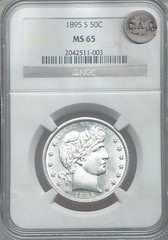

To read the earlier E-Sylum article, see: WAYNE'S NUMISMATIC DIARY: JUNE 15, 2014 (www.coinbooks.org/esylum_v17n25a09.html) QUERY: BOOK WITH PINE TREE SHILLING SOUGHTAlan V. Weinberg writes:
This immediately brought to mind a volume on colonial Massachusetts money that Beverly Hills dealer Jerry Cohen (when he was partners with Abner Kreisberg) offered to me some 30+ years ago. It had a choice Ex Fine Noe 1 Pine Tree shilling under glass embedded in the center of the front leather cover, as made. Jerry priced the book at $5,000 which I found excessive and passed- the coin was then worth perhaps $1,000. I wonder if the book was unique as bound with the genuine shilling and where it is today? That coin, assuming the reverse was as choice as the obverse, would be a $20K coin today.
This is a topic we touched on in 2010. Since then no one has reported a sighting of the book Alan mentioned. Can anyone help? Has the poor book been dismembered? I wonder what the author and title was. -Editor
To read the earlier E-Sylum article, see: QUERY: COIN BOOKS WITH AN ENCASED COIN OR MEDAL (www.coinbooks.org/esylum_v13n30a09.html)
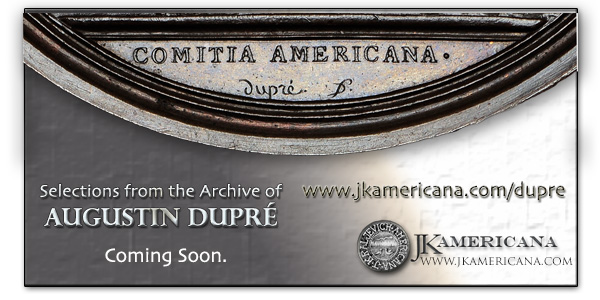
JEFFERSON'S NOTES ON THE STATE OF VIRGINIA
Anne E. Bentley, Curator of Art & Artifacts at the
Massachusetts Historical Society sent this note inspired by Dan Hamelberg's copy of the first English version of Jefferson's Notes on Virginia. Thanks.
-Editor
If you’re curious about how he thought and wrote…he literally cut and pasted his corrections and additions, which made for an absolutely illegible document on microfilm. With the magic of computer code and a bevy of incredibly talented code writers here on staff, we are able to let readers play with the manuscript and see what lies beneath the corrections/additions, just as I did when I first soaked them apart. Enjoy!
For more information and a video starring Anne Bentley, see: Notes on the State of Virginia (www.masshist.org/thomasjeffersonpapers/notes/) To read the earlier E_Sylum article, see: RARE U.S. MINT-RELATED DOCUMENTS COMING TO NBS (www.coinbooks.org/esylum_v17n26a02.html) THE MEDALLIC ART COMPANY MEDAL ARCHIVE
Dick Johnson submitted these thoughts on the study of recipients or awardees of award medals, and the information available to researchers in the Medallic Art Company medal archive.
-Editor
Scott Miller should be thanked for revealing the book on a recipient of the Vail Medal. The study of recipients or awardees of award medals is useful for the background it furnishes on such award medals. Whenever a collector acquires an award medal with the name inscribed his first reaction is "Who was that person and how famous or what did he do?" It adds to a medal's lore to research this information It might appear at first to be outside the realm of numismatics for such data, but often it has a relationship to the value of the piece. Famous names bring higher sales prices. When I was charged with cataloging all the medals made by Medallic Art Company I saw in the company records the names of all such recipients in the shop orders. These had to be inscribed by a staff engraver before the medal was finished and shipped. [You engrave a die but you inscribe a medal. However medals are inscribed with engraving tools or by machine engraving.] I faced the question -- should I record those names, some of which went back to the 1920s. I was recording the name of the medal. date it was first issued, artist(s) names, all sizes and compositions in which the medal was struck, client's name and location, how the client used the medal, and a number of keywords of design elements. This was the essential data the company needed for future use. All this was entered on a 3 x 5 card. (This was before computers.)
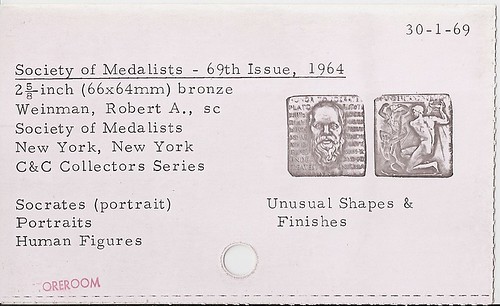
What I didn't record was a numismatic description, quantity struck -- and the names of all those recipients. I felt it was not our right to reveal that data. It was the client's responsibility to publish those names. Often at a presentation ceremony, it was the client's intention the name should be a surprise. Woe to anyone who revealed the name in advance of their ceremony or press release. Thus for 70 years the firm never released recipients'' names. I learned later there exists books on these awards -- as Scott had found -- on one or even the entire list of recipients. Some award programs are decades old, ongoing, some awards made every year, some only occasionally (I assume when someone merits the award). I add those award books to my library whenever I learn of them. I feel this information adds allure and lore to a medal which is named. By the way, that 3 x 5 card file still exists. I had cataloged nearly 7,000 medals. Photographed the medal (both sides), that image is on the card with the data above mentioned. The medal photographed became the archive medal. Six cabinets of those archive medals also exists. These have gone through several owners but now reside at MACO's plant in Dayton, Nevada. One of those owners had all the data on the cards entered in a databank. Note that the catalog number at the upper right on illustrated card has now entered the 21st century. The first two digits was the last two digits of the year issued. These have all been brought up to date because we now have 2000 years conflicting with early 1900 years. The new catalog number for this medal is: 1930-001-069. The information can be easily retrieved. MACO has a full-time archivist. She answers questions on one or two past issues from collectors and the public by email only: Cathy.Swinburg@nwtmint.com (Include a scan and diameter or dimensions of the piece.) To read the earlier E-Sylum article, see: THEODORE N. VAIL NATIONAL AWARD MEDALS (www.coinbooks.org/esylum_v17n26a13.html) THE BOOK BAZARRECONGRESSIONAL GOLD MEDAL FOR THE KINGS
This week a Congressional Gold Medal was posthumously awarded to
Martin Luther King Jr. and Coretta Scott King. Here's an excerpt from a Washington Post article on the ceremony.
-Editor
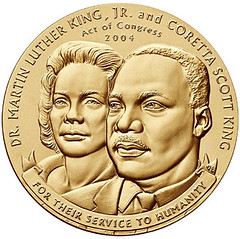
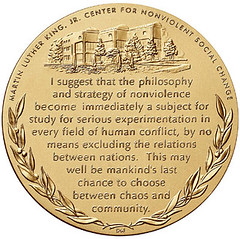
Fifty years after their instrumental role in the passage of the Civil Rights Act, the Rev. Martin Luther King Jr. and Coretta Scott King were posthumously awarded the Congressional Gold Medal, the nation’s highest civilian honor, on Tuesday. The presentation of the medal for the Kings -- considered the foremost leaders of the 1960s Civil Rights movement that won black Americans equal voting rights and fought to free them from institutional segregation in the Jim Crow South – comes a year after Congress gave the honor to the “Four Little Girls” killed in the 1963 Birmingham church bombing, a pivotal moment in the movement. "We gather here in the Capitol to honor Dr. Martin Luther King Jr. and his beloved wife, Coretta Scott King, one of the most distinguished and admired husband and wife teams of the 21st century," said Rep. John Lewis (D-Ga.), himself a leader in the Civil Rights movement. "Often history remembers speeches of facts and figures, but I cannot forget their love. From their union came an enduring strength that carried many of us through the darkest days of the movement." Other Civil Rights-era figures who have been honored with the Congressional Gold Medal include Rosa Parks (1999), who became the face of the Montgomery, Ala., bus boycott when she refused to leave her seat and move to the back of the bus, a section reserved for blacks, and Dorothy Height (2004), one of the most prominent women of the movement, who organized “Wednesdays in Mississippi,” a dialogue series in which northern women traveled to southern cities to work to foster harmony during the contentious civil rights years. The Kings were initially awarded the medal in 2004, but Coretta Scott King passed away before she could receive the medal. Congress then needed to re-pass legislation so that the physical medal could be given to the Smithsonian.
What kind of gift is that? If you're giving someone a Congressional Gold Medal, shouldn't you actually GIVE them a GOLD medal? In the King case both recipients were deceased, but why can't a family member accept the medal? Is that in the underlying law? Or does it just depend on how the act authorizing each particular medal is written?
It's a huge honor regardless, but it looks like the government is giving itself (The Smithsonian) a gold medal, not the recipients. In the case of multiple recipients such as the Code Talkers, it naturally doesn’t make economic sense to strike medals in gold for every last person in the group. But to not actually give out a gold medal to anyone or any organization cheapens the whole affair. Maybe we should print up T-Shirts saying "I went to Washington to accept a Congressional Gold Medal and all I got was this shirt and a bronze replica they sell in the gift shop for 40 bucks." -Editor
To read the complete Washington Post article, see:
Congressional Gold Medal awarded to the Rev. Martin Luther and Coretta Scott King
(www.washingtonpost.com/blogs/post-politics/wp/2014/06/24/ During a ceremony held yesterday at the Capitol Rotunda, the Congressional Gold Medal was posthumously awarded to Martin Luther King, Jr. and Coretta Scott King. The medal was accepted by Lonnie Bunch, founding director of the Smithsonian National Museum of African American History and Culture. The obverse design of the medal features portraits of Dr. King and Coretta Scott King. Their names appear inscribed above, along with “Act of Congress 2004″. A banner at the base carries the inscription “For Their Service to Humanity”. The reverse design features the image of the Martin Luther King, Jr. Center for Nonviolent Social Change. Below the image is a quote from Dr. King reflecting his beliefs of nonviolent social change. The lower half of the medal is encircled by a laurel wreath. The quote reads: “I suggest that the philosophy and strategy of nonviolence become immediately a subject for study for serious experimentation in every field of human conflict, by no means excluding the relations between nations. This may well be mankind’s last chance to choose between chaos and community.” The United States Mint is offering bronze reproductions of the Congressional Gold Medal. The 3-inch bronze medal is priced at $39.95 and the 1.5-inch bronze medal is priced at $6.95. The bronze medals went on sale today, June 25, 2014. To read the complete article on the Mint News Blog, see: Dr. Martin Luther King, Jr. and Coretta Scott King Bronze Medal (mintnewsblog.com/2014/06/dr-martin-luther-king-jr-and-coretta-scott-king-bronze-medal/) 1897 QUEEN VICTORIA DIAMOND JUBILEE MEDAL
One actual gold medal that caught my eye this week is an 1897 Queen Victoria Diamond Jubilee medal offered at fixed price by Baldwin's.
-Editor

Victoria (1837-1901), Diamond Jubilee, 1897, Gold Medal by G W de Saulles after T Brock and W Wyon, veiled bust left, VICTORIA ANNVUM REGNI SEXAGESIMVM FELICITER CLAVDIT XX IVN. MDCCCXCVII., rev young head left, on laurel, LONGITVDO DIERVM IN DEXTERAEIVS ET IN SINISTRA GLORIA, 1837, 26mm, 12.84g (BHM 3506; E 1817b). Minor edge marks, otherwise good very fine.
The Baldwin's web site has a neat magnifying glass feature that pops up when you hover your mouse over a coin image. Check it out.
-Editor
For more information, or to order, see: Victoria, Diamond Jubilee, 1897 (www.baldwin.co.uk/victoria-diamond-jubilee-1897-6456.html) MEDALS HONOR UNITED STATES CHAPLAINS
Mel Wacks of the Jewish-American Hall of Fame submitted a press release about some new medals the organization has struck. Here's an excerpt.
-Editor
The Jewish-American Hall of Fame is the longest continuing series of art medals being produced in America. Launched in 1969, its 2014 medal, honoring United States Chaplains, features Rabbi Jacob Frankel, the First U.S. Jewish Chaplain, and Rabbi Alexander Goode, along with the other Immortal Four Chaplains. The medals were designed by Eugene Daub, who has designed 7 of the last 8 medals in this long-running series. Eugene is the second most frequent contributor to the Jewish-American Hall of Fame series, lagging only Gerta Ries Wiener, who created 11 medals between 1971 and 1994. Rabbi Jacob Frankel, the First U.S. Jewish Chaplain The Four Chaplains The Dorchester left New York on January 23, 1943, en route to Greenland, carrying the four chaplains and approximately 900 others, as part of a convoy of three ships. During the early morning hours of February 3, 1943, at 12:55 a.m., the vessel was torpedoed by a German submarine off Newfoundland in the North Atlantic. The torpedo knocked out the Dorchester's electrical system, leaving the ship dark. Panic set in among the men on board, many of them trapped below decks. The chaplains sought to calm the men and organize an orderly evacuation of the ship. As life jackets were passed out to the men, the supply ran out. The chaplains removed their own life jackets and gave them to others. They also helped as many men as they could into lifeboats, and then linked arms and, saying prayers and singing hymns, went down with the ship. On December 19, 1944, all four chaplains were posthumously awarded the Purple Heart and the Distinguished Service Cross. In addition, the Four Chaplains' Medal, was approved by a unanimous act of Congress on July 14, 1960, through Public law 86-656 of the 86th Congress. The medals were presented posthumously to the next of kin of each of the Four Chaplains by Secretary of the Army Wilber M. Brucker at Ft. Myer, Virginia on January 18, 1961. Ordering Mel adds: Mention that you read about this in The E-Sylum and take a 20% discount. To read the complete article, see: Chaplains Rabbi Jacob Frankel (1808-1887) & Rabbi Alexander Goode (1911-1943) (www.amuseum.org/jahf/virtour/page45.html)

COIN PRESS MAKER SCHULER TURNS 175
German industrial giant Schuler is known in the numismatic world for making coin presses which power Mints around the world. An article in the June 26, 2014 issue of CoinsWeekly discusses the company's 175th anniversary.
-Editor
It’s Schuler’s birthday: the internationally successful press manufacturer is celebrating its 175th year in business in 2014. Louis Schuler founded the company in 1839 as a metalworking shop in Göppingen’s Sauerbrunnengasse. Nobody at the time would have thought that the little workshop would one day become a global corporation with sales of almost € 1.2 billion. ‘There have been many milestones in Schuler’s success over the past 175 years,’ says CEO Stefan Klebert, ‘and very few companies in Germany can look back on such a long and successful history.’ A 175th company anniversary is rare: not even half of all German companies reach their 10th anniversary. To mark the occasion, Schuler’s celebrations will therefore include a central event for employees at its base in Göppingen, Germany, to be held in July. In addition, a special website presents 175 minor and major moments which have shaped Schuler over the years. These include, for example, the moment in 1852 when founder Louis Schuler – inspired by the Great Exhibition in London one year previously – decided to dedicate his future to the construction of machines for sheet metal processing. The Industrial Age for minting technology began only about 1870. Motor-driven knuckle-joint presses replaced the strenuous manual labor of the previous age. Schuler was already delivering presses to mints in these early days. This is evidenced by several historical documents, including a letter from the Royal Württemberg Mint dated 1874.
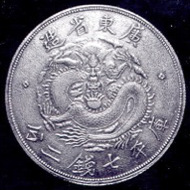
1895 Schuler Sample coin for China National Mint At the turn of the century, Schuler knuckle-joint presses were producing coins at rates up to 60 per minute – a remarkable achievement then. A 1905 report by the Mint and Foundry Masters of Saxony, Buschick and Choulant, mentions a visit to Schuler and 30 presses destined for China Until the early 1980s, the company delivered more than 1,000 minting presses with various improvements and new features to about 50 countries. A number of presses from this era are still in use today. With the development of the MRH / MRV series of minting presses, a new epoch of minting technology dawned in the 1980s.

Schuler coin presses at the Mexico National Mint To read the complete article, see: Schuler celebrates 175th anniversary (www.coinsweekly.com/en/News/4?&id=2850) To read an earlier CoinsWeekly article on Schuler, see: Coin minting presses for the entire world (www.coinsweekly.com/en/Coin-minting-presses-for-the-entire-world/4?&id=2257) ART EXHIBIT DISPLAYS BARRELS OF MONEY
Today's Art Daily newsletter alerted me to an exhibit of a great painting that money collectors will appreciate: Barrels of Money by Victor Dubreuil.
-Editor
This exhibition marks a new stage in the exploration of American art by the Fondation de l’Hermitage, which began with Andy Warhol (1995), followed by L’impressionnisme américain (2002) and Edward Hopper (2010). It is also part of a series of exhibitions focusing on the great centres of Western art in the 19th century, from Impressions du Nord. La peinture scandinave (2005) to La Belgique dévoilée (2007) and, more recently, El Modernismo. De Sorolla à Picasso (2011). The European public remains little aware of American genre painting, which considerably developed during the 19th century and is presented here through over 70 works. Pride of place goes to landscape, with the artists of the Hudson River School (Thomas Cole, Jasper F. Cropsey, Albert Bierstadt, Frederic E. Church and Thomas Moran) and the Luminist movement (John Kensett, Fitz Henry Lane). Several portraits of Native Americans by George Catlin are on display, alongside scenes of everyday life and portraits by the realist painters Thomas Eakins and Richard C. Woodville. Finally, works by William M. Harnett, John F. Peto and John Haberle illustrate the highly original renewal of the still life. A set of photographs of landscapes and portraits of Native Americans completes the presentation.
Harnett, Peto and Haberle still lifes over include realistic images of coins and paper money of the day. Unfortunately, none of their works seem to be illustrated on the web sites.
-Editor
To read the complete article, see:
Major exhibition of 19th century American painting opens at Fondation de l'Hermitage
(artdaily.com/news/71112/Major-exhibition-of-19th-century To visit the Fondation de l’Hermitage web site, see: www.fondation-hermitage.ch
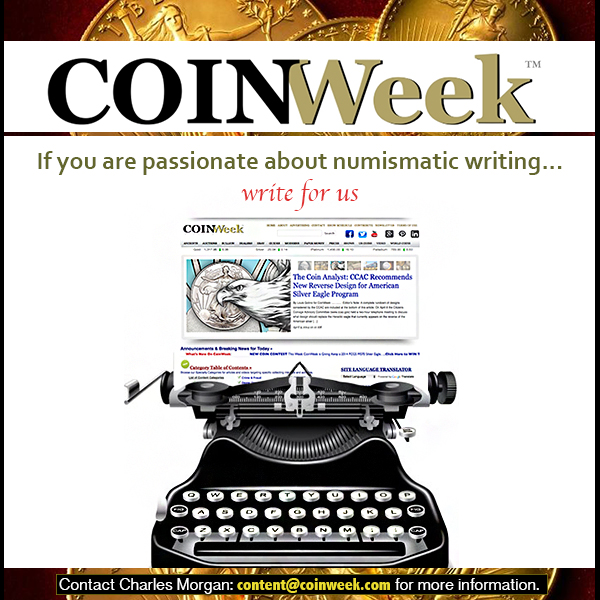
WAYNE'S NUMISMATIC DIARY: JUNE 29, 2014
Galiette was at the podium when I arrived; Dave Bowers was seated in the front row answering a question about the small change panic of 1862. I took a seat behind him in the second row. Among the audience were Charles Morgan of CoinWeek, David Schenkman, and Heather and Eric Schena. Afterwards copies of their book were given to all attendees, which Dave and Rob kindly autographed. I'd never met Rob before, so I introduced myself and thanked him for making a great book full of interesting historical and economic background on the place of these coins in the nation's history. He's an avid E-Sylum reader. After chatting with several people while waiting for Dave to free up, he and I walked down the hall to speak with Vicken Yegparian in the auction room, who directed us to where to find Stack's Bowers Galleries President Brian Kendrella. I sat down with Brian for a while and had a nice discussion about the SBG web site and a web project of my own that I've been working on. I rushed back to room 301 where David Schenkman was just starting his presentation on Trade Token Denominations. I took a seat in the second row behind Simcha Kuritsky. Also present were Simcha's fellow Maryland State Numismatic Association members Bryce Doxzon and Scott Barman, all clad in their red MSNA jackets. Eric Schena ran the projector while Dave treated the audience of about 25 people to a delightful discussion on tokens. Partway through Dave discussed the recent E-Sylum quiz based on images from his talk. He gave The E-Sylum a plug as the "greatest bargain in numismatics," a lengthy weekly newsletter with great news and information, all for free. He invited people to see me afterwards to sign up, and two of them did, which is how I got to meet new subscribers Carol Fink and Harold Roberts. Speaking of our quiz, no one wrote in to identify the issuer of the 1 2/3 cent token pictured last week. Dave figured this would be a tough one. Here's the answer, as revealed in Dave's presentation.
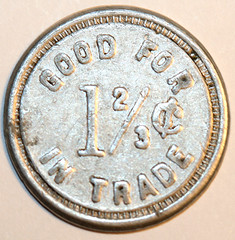
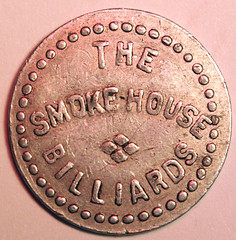 Trade Token: The Smokehouse / Billiards (location unknown)
Trade Token: The Smokehouse / Billiards (location unknown)
Dave supplied the above images of the complete token. He writes: The token was located at the site of a billiard hall in Norton, Virginia, but so far I haven’t been able to confirm the attribution. Afterwards I went down to the bourse floor. I waved and said hello to Julian Leidman at his usual table right near the entrance. He was busy with a customer, so I moved on. Tony Terranova was busy as well, but I came back and chatted with him a bit. Missing was his usual next-door-neighbor John Kraljevich, who was missing from the show due to the ANA Summer Seminar. It seemed everyone was busy; the aisles were pretty full and I never did get a chance to sit with Charles Morgan. I did talk briefly with E-Sylum advertisers Steve Hayden and Wayne Herndon. On the way out I met up again with Dave Schenkman and Heather and Eric Schena. After chatting a bit I went looking for Len Augsburger. I found him in a conversation with Robert Galiette and Kevin Flynn. I horned in (or tried to), but Rob was doing all the talking. In a good way, though - he's effusive and enthusiastic about the numismatic hobby we share. Len adds: Robert is an animated and enthusiastic researcher, and you quickly sense that he is like a kid in candy store when surrounded by old papers and documents. It was nice to put a face with the name and I was sorry I had not brought my copy of the book to get a signature. I look forward to another opportunity in the future. Seeking a free Wi-Fi connection Len and I walked over to Harborplace and took a seat in a food court area. He bought us some drinks and nacho chips from Moe's while I set up my computer. I gave him a walkthrough of slides for the "Future" part of my "Past, Present and Future of Online Numismatics" talk at the NBS General Meeting later this summer. By the time we wrapped up it was after 5pm, and Len had to get back to the bourse floor. As for me, I was done and ready to get home to my family. But next time I won't be in such a hurry, because trying to get out of Baltimore on a Friday rush hour was a nightmare. I crawled thru traffic and was only just hitting the highway when I got hungry and decided to stop for dinner. When I got back on the highway the road was wide open all the way home to Virginia. Eric and Heather had the right idea - they went to the ballgame Friday and stayed the night in a hotel. Afterwards Eric told me about one of his purchases at the show, a very nice Labor Exchange note from Atlanta, GA (a collecting interest we share). He sent me these images:

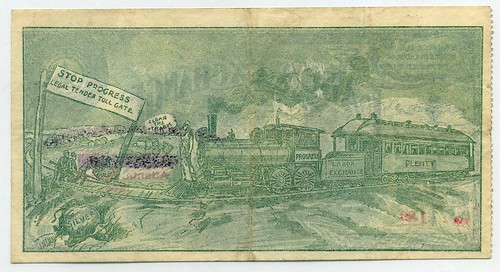
Eric adds: I love this sort of thing. I may try to do a detailed study if someone else hasn't already started one. It's funny, I spent maybe an hour on the bourse, that's it. The rest of the time I was chatting with folks, learning stuff at both talks, and discussing books. Me, too. Meeting up with people is something you just can't do online. I'm already looking forward to my next coin show, likely the August ANA show.
To read the earlier E-Sylum articles, see:
THE BOOK BAZARREBRITISH VIRGIN ISLANDS ROWLAND HILL COINS
Yossi Dotan submitted these thoughts on a numismatic connection to the rare British Guiana one-cent magenta stamp. Thanks!
-Editor
Actually, there is a numismatic connection: the stamp is featured on two coins issued by the British Virgin Islands in 2004 to commemorate the 125th anniversary of the death of Rowland Hill—a $5 coin in .990 red titanium (KM#284) and a $75 bi-metallic coin, .990 red titanium core in .999 gold ring (KM#285), for which I attach an image found in sales material of the Pobjoy Mint. The narrative of the two coins in my book Watercraft on World Coins, Vol. II: America and Asia, 1800-2008 follows: "The reverse depicts the 1-cent stamp of 1856 of British Guiana which features the same vessel as that shown on the colony's badge (see East Caribbean States KM-7) and bears the colony's Latin motto DAMUS PETIMUS QUE VICISSIM (We Give And We Seek in Return). The obverse depicts Queen Elizabeth II. The stamp was printed in British Guiana (now Guyana) in black ink on magenta (purplish red) paper. Its corners were snipped off, giving it an octagonal shape. The printing was ordered as an emergency issue by E.T.E. Dalton, the colony's postmaster, when the stock of regular stamps of the colony was sold out before arrival of a fresh shipment from Waterlow & Sons, the London printers. The stamp, at the 1-cent rate for newspapers (the rate for letters was 4 cents), was initialed by a post office employee as a security measure. The only stamp known of this issue was discovered in 1873 by a 12-year-old schoolboy living in Georgetown, British Guiana. It is the world’s rarest stamp and was sold in 1980 for $935,000. The coin honors Rowland Hill (1795-1879), an English schoolmaster who in 1837 published a pamphlet titled Post Office Reform: Its Importance and Practicability, in which he proposed the use of pre-printed envelopes and adhesive postage stamps to indicate prepayment of postage. Hill’s plan also called for a uniform low postage rate to anywhere in the British Isles, instead of the existing variable rate that depended on distance and the number of sheets of paper used and which was payable by the receiver. Hill’s invention, for which he was knighted, made communication by mail both affordable to the masses and practical, and resulted in the issue of the first stamp in the world in England in 1840. The titanium of the coins was colored red through a special heat process, to convert the metal from the silver-white color obtained upon refining. The red color alludes to the color of the stamp. Titanium was discovered in 1791. The first coin made of the metal was issued by Gibraltar in 1999." A nice increase in value for that stamp—from $935,000 in 1980 to $9,500,000 now!
Sometimes the best system is a simple one, and often this only becomes clear once it’s tried. Hooray for Rowland Hill. You know, the Internet offers a similar one-price-fits-all scheme; can you imagine how difficult it would be if we had to keep track of how large our email messages are, and how far they traveled? A newsletter like ours would be insanely difficult to manage.
-Editor
To read the complete article, see: BRITISH GUIANA 1C MAGENTA STAMP SETS RECORD (www.coinbooks.org/esylum_v17n26a20.html) 'MYSTERY COIN' FOUND IN JERSEY HOARD
Via the Explorator newsletter comes this item from the BBC about a mystery coin found in a hoard under study. Can anyone help?
-Editor
The hoard of some 70,000 coins and jewellery pieces was found by two metal detector enthusiasts in 2012. Jersey Heritage conservator, Neil Mahrer, is working on separating the coins in full view of the public at the Jersey Museum. He said so far experts had not been able to work out its origins due to an unusual "geometric pattern". Mr Mahrer said: "Our Celtic coin expert Philip De Jersey has been our go-to man for instant identification of anything strange and he usually mails us straight back with our answer but this coin has stumped him. "He reckons its Armorican but the geometric pattern is apparently unknown, which is always exciting." Mr Mahrer and his team are working in a glass fronted room as part of the Treasure: Uncovering Celts and Romans exhibition at the Jersey Museum. It is designed to allow visitors to watch as the team remove gold and silver objects as well as coins from the hoard, thought to be worth about £10m. To read the complete article, see: 'Mystery coin' found in Jersey hoard (www.bbc.com/news/world-europe-jersey-27943738) ONGOING DEBATE ON LOOTING AND COLLECTING
Also via the Explorator newsletter is this Science Daily article blaming coin looting on collectors.
-Editor
"Archaeologists are detectives. When something has been taken away from a historical site, the object is divorced from its relationship with other objects, and its utility for the writing of history -- much like solving a criminal case -- is diminished," said Nathan Elkins, Ph.D., assistant art professor in Baylor's College of Arts & Sciences. Elkins is the staff numismatist at the excavations of an ancient synagogue from the Roman/Byzantine period in Huqoq, Israel. He has written an article, "Investigating the Crime Scene: Looting and Ancient Coins," that appears in the current issue of Biblical Archaeology Review. Numismatists -- those who study or collect such currency as coins, tokens, paper money and even such trade objects as shells or lambskins -- must not condone or, worse, encourage that destructive behavior, Elkins said. Coins are among objects stolen and sold through the multi-billion-dollar black market in antiquities. The New York Times recently reported looting in Spain and also in Egypt, where looters have taken advantage of political upheaval to steal thousands of objects from unprotected sites and even a national museum. The U.S. market alone imports "hundreds of thousands of earth-encrusted coins annually that are smuggled from Balkan nations such as Bulgaria," Elkins says. Coins taken in such illegal and secretive excavations and touted with fake histories are easy to find in auction catalogs and online storefronts -- and inexpensive to boot, he said. "'Common' coins such as these may sell for the price of a fast-food lunch, but they're invaluable sources to archaeologists and historians," he said. When discovered beneath floors, foundations or wells, they provide information about how people lived and behaved in the past and can date occupation levels and monuments. Elkins noted that there is "a widespread demand for biblical coins on account of their associations with Judaism, Christianity and the Bible, which of course exacerbates the looting problem. And the intellectual and material consequences of looting biblical coins are equally severe as that of Roman imperial coins and Greek coins." For some coin collectors, obtaining coins of questionable origin is a matter of short-sightedness, he said. The origin and history of a coin may be irrelevant to them if their interest is merely in its image, rarity and method of production. Some scholars and collectors may be hesitant to question a coin's background for fear of alienating dealers or other collectors, Elkins said. And, to be fair, some coins are in public or private collections with no recorded history rather than having been illegally obtained and passed off with a fake history, he said. Elkins said that most collectors have "a genuine passion" for ancient history, but they must be more assertive and conscientious in reporting suspected illegal activity, insisting on the provenance of coins and avoiding giving money to those who buy from looters and smugglers. To read the complete article, see: 'Smoking gun' ancient coins are being looted from excavations (www.sciencedaily.com/releases/2014/06/140616203724.htm)
I doubt there are many numismatists who would deny that the coin marketplace creates incentives for looters. The problem for numismatists is the push to assume guilt on the part of a collector who can't prove that his coin WASN'T looted at some point in its 2,000 year history. I don't like Asian sweatshops either, but without worldwide regulation and oversight there's no way I could ever prove my T-shirt wasn’t made in one. The haters are putting the cart before the horse.
At least the Science Daily article is professionally written, unlike the snarky tone of this screed against Ras Suarez, author of The Encyclopedia of Roman Imperial Coins . -Editor Over on the Biblical Archaeological Review blog a gaggle of coineys has converged to discuss "preserving provenance" of dugup antiquities (or rather why they say we should not bother, because it's bad for business). Rasiel Suarez goes on to suggest that ancient coin collectors are not only passionately interested in history, but have "skills in conservation and a desire to preserve and reconnect with the past". The dealer then goes on to say that in his opinion, "illicit does not equate to immoral", which will be news to many people I am sure. He tries to claim that the onus is on the critics to show why there are negatives in the no-questions buying of dugup artefacts of unknown origins and collecting history. In the same way I am sure there are dealers in such things who might raise the same points about cars, bikes and firearms with filed off serial numbers, but I think the rest of us can see through this line of argument. Personally I would steer clear of any dealer in any commodity who was expecting me to buy possibly illicit stuff ‘blind’ like that. What are missing from their offer are coins from the UK, where detecting on archaeological sites is legal, objects reported by responsible finders to the PAS and exported (as the law requires) with a UK export licence. Now, why would that be? Why are these Dirty Old Coins so "surprisingly affordable"? What about the export licences here? Why is there absolutely no (as in zero) information about this on the Dirty Old Coins website? Now, you can get Bulgarian export licences, I saw some at the Warsaw coin show last year, so has Mr Suarez and his partners got them for these coins? And where did they come from? How did they get on the market in the first place? The old apotropaic formula "Old collection, predating the legislation and conventions" really seems difficult to apply here, to Dirty Old Coins, still dirt-encrusted.
'PAS" is the Portable Antiquities Scheme, a perfect example of the better regulation and oversight needed worldwide. In my time living in London I began to feel that there was no more civilized place anywhere in the world, and the PAS is another fine piece of evidence for that thesis. The PAS leverages market forces IN FAVOR of archeology and conservation by ensuring that finders have a strong economic incentive to report their finds to the authorities. Absent such an incentive (as in most of the rest of the world), finders quickly become looters and only looters want to find.
The Jersey hoard discussed elsewhere in this issue is a prime example. Hoards like this discovered in any other place would never be reported, and end up smuggled out of the country, landing anonymously in collections worldwide with no legitimate provenance chain.
-Editor
To read the complete article, see: Dirty Old Coin Dealings (paul-barford.blogspot.com/2014/06/dirty-old-coin-dealings.html)
Explorator editor David Meadows invented a new word, the plural of E-Sylum, in his preface to a collection of links to "Three weeks' worth of e-Syla"
"EXPLORATOR is a free weekly newsletter bringing you the latest news of archaeological finds, historical research and the like." To subscribe to Explorator (a great newsletter!), send a blank email message to: Explorator-subscribe@yahoogroups.com . -Editor

PROCLAMATION MEDAL FOR SPAIN'S KING FELIPE VI
A June 24, 2014 Coin Update article by Michael Alexander discusses the new proclamation medal for Spain's new king.
-Editor
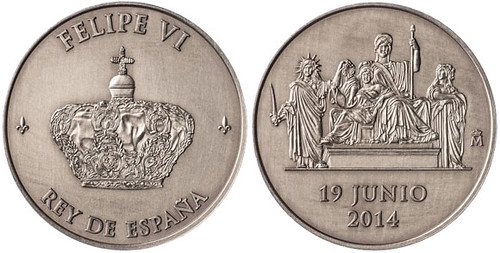
The Real Casa de la Moneda de Espana have announced the issue of an official proclamation medal on the occasion of the accession of their new Monarch, HM King Felipe VI who succeeded his father King Juan Carlos I on the 19th June. King Juan Carlos I announced his intention to abdicate on the 2nd June after a reign of 38 and a half years. King Juan Carlos ascended to the Spanish throne on the death of the then-country’s head of State, General Francisco Franco who himself, had ruled Spain for almost four decades, since 1936. King Juan Carlos I is credited with placing the country onto a path of democratic reform – a new constitution which was adopted by the people by referendum guaranteeing the rights of the people to parliamentary government and to a constitutional monarchy and limiting royal prerogatives was signed into law by the King in 1981. King Juan Carlos unexpectedly announced his intention to step aside and the instrument of abdication was officially signed on the 18th June in the Palacio Real in the presence of the Prime Minister and cabinet along with senior members of the Royal family. The abdication took effect at midnight and the country’s new King Felipe VI was proclaimed in the Cortes where Felipe VI took his oath of office. The new king, who had held the title of Prince of the Asturias – the traditional title for the heir to the Spanish throne was born in 1968 and officially invested with his constitutional position as next in line to succeed his father on his 18th birthday in 1986.Prince Felipe attended University in the US and graduated with a Master’s degree of Science in Foreign Service from Georgetown. Prince Felipe married his fiancé, Letizia Ortiz Rocasolano, an award-winning television journalist in 2004, who now becomes Queen Letitzia. The couple’s first child, a daughter named Leonor was born in 2005 with the couple’s second child, Sofia born in 2007. With the accession of Felipe as King, Princess Leonor becomes her father’s heir and first in the order of succession to the Spanish throne. The medal, which depicts Spain’s crown in the center on the obverse, also includes the name of the new King “FELIPE VI” above along with the text “REY DE ESPANA” just below. Two fleur du Lyis ornaments are seen on either side of the crown. The reverse depicts the allegorical figures seen on the edifice of the Chamber of Deputies, where the proclamation of the King’s accession was read. The date of accession “19 JUNO 2014” is seen below the primary design.
To read the complete article, see:
Royal Proclamation Medal Issued for Investiture of King Felipe VI
(news.coinupdate.com/royal-proclamation-medal SOME RECENT COIN DESIGNS: JUNE 29, 2014
It's been a while since I've had time to discuss new coin designs. Here are a few that caught my eye in the backlog of the last several weeks. Unless otherwise noted, these are all courtesy of ultramodern numismatist Pabitra Saha. Thanks!
-Editor
Spain's Bimetallic World Cup Coin 
Turkey's Coin on Turkish-Poland Diplomatic Relations 
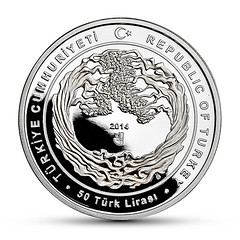
Poland and Turkey have each issued coins celebrating their 600 years of diplomatic relations.
-Editor
Turkey Gelidonya Lighthouse Coin 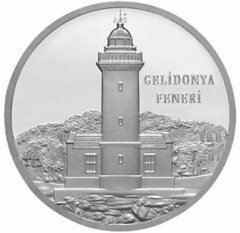
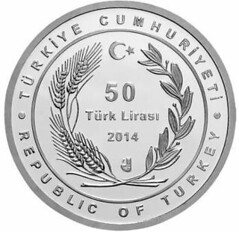
I like this one. It's simple and well done. San Marino Gino Bartali Coin 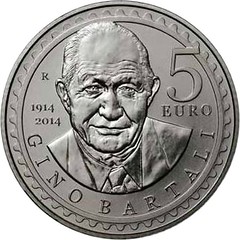
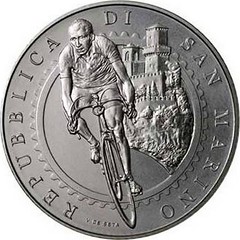
Not many coins show people on bicycles. This one is nicely done all around. I like it. Lithuania 10 Litu Coin on Science 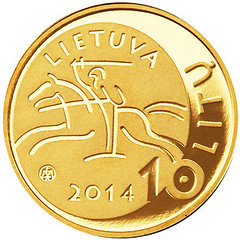
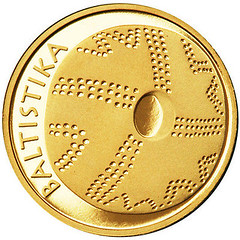
I'm not sure what to make of this one, I don't care for the flat stick figure horse and rider on the obverse, and don't know what I'm looking at on the reverse. Could someone look it up and enlighten us? Turkey's First Coin of Mankind Coin 
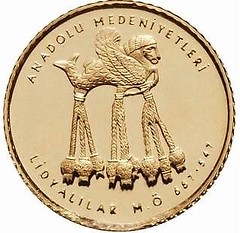
Great piece for the coin-pictured-on-a-coin collectors. But what is that on the reverse? A poodle from hell on stilts?? Anyway, here's an image of one of the originals. 
Kroisos, Stater of Lydia, ca. 560 BC PETITION SEEKS TO HONOR WWI NURSE EDITH CAVELL
Philip Mernick forwarded an update on a Change.org petition to spur the Royal Mint to create a coin honoring WWI nurse Edith Cavell. I was unaware of her tragic story and hope the effort succeeds. First, here's an excerpt from the original petition.
-Editor
Lord Kitchener represents all that I have always loathed about the First World War - the jingoism, the sheer waste of men, the "Lions led by Donkeys" mentality. And then I thought of Edith Cavell, a heroine of my early childhood. The nurse who was executed for giving succour to all wounded soldiers regardless of nationality. The woman who is celebrated for saving the lives of soldiers in Brussels from all sides without distinction. She and Belgian and French colleagues helped over 200 Allied soldiers escape from German-occupied Belgium. She was arrested, tried with 33 others by a German military court, found guilty of ‘assisting men to the enemy’ and shot by a German firing squad on October 12 1915. "I realise that patriotism is not enough, I must have no hatred or bitterness towards anyone", these are her last words. She did not want to be remembered as a martyr or a heroine but simply as "a nurse who tried to do her duty". In the year in which we commemorate the First World War she should be honoured by her country as a woman who was one of the best.
The petition has reached an amazing 110,000 electronic signatures.
Here's the latest update, a comment from Chancellor of the Exchequer George Osborne.
-Editor
Mr Osborne: As well as being Chancellor of the Exchequer, I am Master of the Royal Mint. I can therefore address the hon. Gentleman’s question directly. I am certainly aware of the campaign, and I of course honour the bravery and sacrifice of Edith Cavell. There will be a whole series of coins to commemorate the first world war, some of which will be in general circulation and some of which will be for collectors. Like previous Governments, we act on the advice of a Royal Mint advisory committee on these topics, but I will directly take up with it the suggestion of marking Edith Cavell’s sacrifice and make sure that it is honoured in an appropriate way.
Petition organizers will be "pressing on to ensure that we have a £2 coin that goes into general circulation & not just a collector's coin" Good luck!
-Editor
To read or sign the petition, see:
The British Treasury: Issue a £2 coin with the face of Edith Cavell on it
(www.change.org/petitions/the-british-treasury-issue-a-2-coin
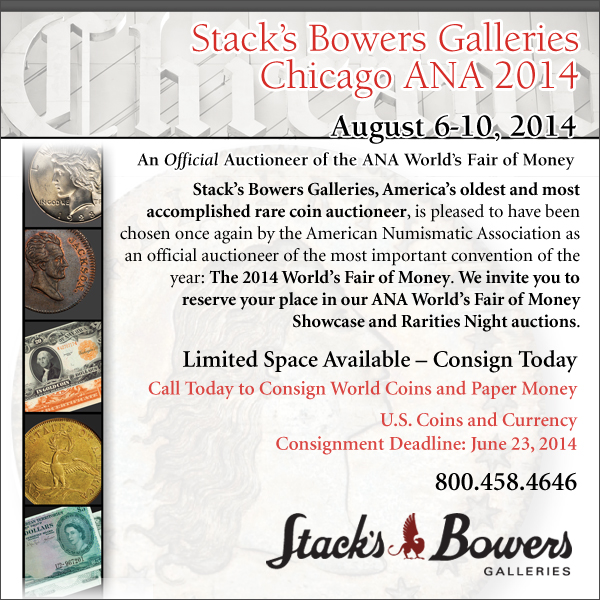
CANADIAN GRIFFON DOLLAR SHIPWRECK FOUND?
Usually the numismatic connection to a shipwreck story is in the coins brought up from the wreck. In this case it's a coin which has an image of the ship - the 1979 Canadian Griffon dollar. Thanks to Dick Hanscom for forwarding this item from he Daily Mail.
-Editor
According to Steve Libert, his crew found the debris this month about 120 feet from the spot where they removed a wooden slab a year ago that was protruding from the lake bottom. Libert believes that timber was the bowsprit of Rene-Robert Cavelier, Sieur de La Salle's ship, although scientists who joined the 2013 expedition say the slab more likely was an abandoned fishing net stake. 'This is definitely the Griffin - I'm 99.9 percent sure it is,' Libert said. 'This is the real deal.'
He acknowledged his dive team had found no 'smoking gun' such as a cannon or other artifacts with markings identifying them as belonging to the Griffin. But the nails and other implements appeared similar to those from La Belle, another of La Salle's ships that sank near the Gulf of Mexico, Libert said. To read the complete article, see: Legendary lost ship commanded by 17th century French explorer found after more than 300 years at the bottom of Lake Michigan (www.dailymail.co.uk/news/article-2666611/Explorer-says-Griffin-shipwreck-found.html) NUMISMATIK LANZ AUCTION SALE 158 RESULTS
Ursula Kampmann submitted this item on the results of the recent auction sale at Lanz featuring a Phanes stater and a denarius of Brutus. Thanks!
-Editor
5 June 2014
Numismatik Lanz: 280,000 euros for a stater in the name of Phanes It is an icon of numismatics, the stater in the name of Phanes, enigmatic witness of the earliest coinage. Now it was auctioned at Lanz for 280,000 euros. Slightly less expensive was the famous EID MAR denarius of Brutus that obtained a price of 165,000 euros. More than 1,000 lots were offered by auction house Numismatik Lanz in Munich on 5 June 2014, including two numismatic icons, the stater of Phanes and the denarius of Brutus.
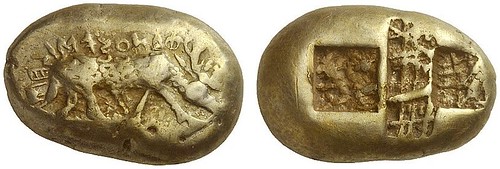
((252 – Phanes (Ephesos / Ionia). Electrum stater, Milesian standard. BMC 1 (same dies = Weidauer 39). Extremely rare. Extremely fine. From Rosen Collection, New York. Starting price: 150,000 euros. Hammer price: 280,000 euros.)) It was the fifth known specimen of the stater of Phanes, that specimen from the Rosen Collection that was offered for sale in auction #158 of Numismatik Lanz. Hence, it is an extremely rare coin type, and of utmost historical and numismatic importance at that. After all, this is the first coin that bears an inscription. ‘I am the badge of Phanes’ is written above a grazing deer, and generations of scholars have given the person (or nature) of that Phanes much thought. One example of this rare coin is housed in the British Museum, a second one is owned by the German Central Bank. Three specimens are available on the market. One of these three now changed hands in Munich for 280,000 euros.
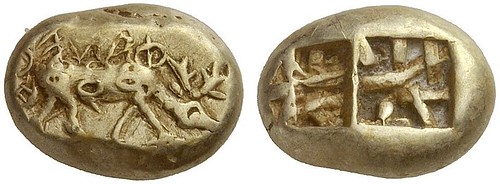
((253 – Phanes (Ephesos / Ionia). Electrum trite, Milesian standard. Extremely rare. Extremely fine. From Rosen Collection, New York. Starting price: 24,000 euros. / Hammer price: 55,000 euros.)) Ten specimens are known to exist of the accompanying trite, of which likewise only two are owned by coin cabinets. The British Museum houses one, the State Coin Collection at Munich the other. Their obverse features the same deer as the stater. The abbreviated inscription reads ‘of Phanes’. Hubert Lanz called out the piece from the Rosen Collection for 24,000 euros, but the price obtained was 55,000 euros in the end.
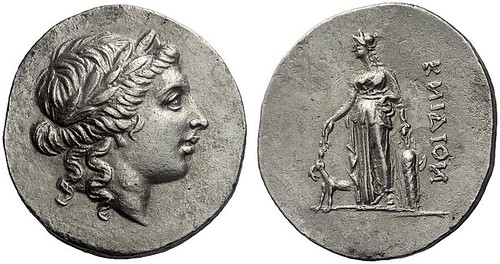
((266 – Cnidus (Caria). Tetradrachm, first half 2nd cent. B. C. Georges LeRider, Un tetradrachme héllénistique de Cnide, p. 155-157, pl. 18. Extremely rare. Extremely fine. Starting price: 30,000 euros. Hammer price: 29,000 euros.)) These were by no means the only highlights in this great selection of magnificent Greek coins. A marvelous Archaic tridrachm from the Thracian city of Apollonia Pontica with the gorgoneion on the obverse rose from 4,800 euros to 11,000 euros. A stater from the city of Cyzicus depicting winged Phobos, a mythical creature consisting of the head of a predator and the body of a human, was called out for 24,000, to ultimately change hands for 34,000 euros. 29,000 euros was the price of the rarest tetradrachm of Hellenistic times, a coin from Cnidus from the first half of the 2nd cent. that shows Artemis Hyakinthotrophos on the reverse. We have pretty good information on the kind of worship this goddess enjoyed at Cnidus thanks to an inscription that invites the citizens of Cos to attend her quadrennial festivities. Likewise remarkable was the result obtained by a tetradrachm from Priene with the depiction of Orophernes on the obverse (starting price: 12,000 euros / hammer price: 19,000 euros) and a tetradrachm from Ake-Ptolemais, that was made during the one-year sole reign of Cleopatra Thea over the Seleucid Empire (estimate: 12,000 euros / hammer price: 18,000 euros).
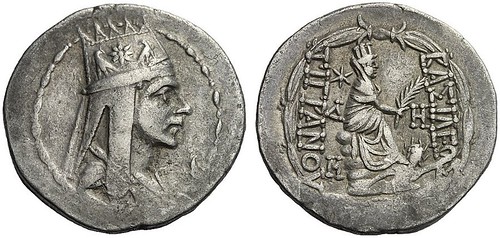
((300 – Tigranes II. Tetradrachm, Antiochia. Nercessian pl. 74 / A65-P8b (Av same die). Starting price: 900 euros. Hammer price: 6,500 euros.)) A pleasant surprise was the result achieved by a small group of almost twenty Armenian coins. The modest pre-sale estimate had amounted to 7,290 euros. All pieces achieved a multiple of that sum, which resulted in a hammer price almost four times the estimate, i.e. 26,900 euros. To single out just the most expensive piece here: a tetradrachm, minted in Antiochia for Tigranes II. This was the rarer variety with the small head. It was called out for 900 euros, only to arrive at impressive 6,500 euros in the end.
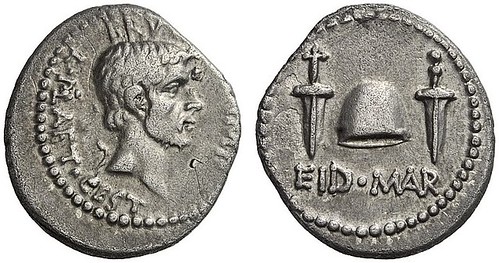
((373 – M. Iunius Brutus, + 42. Denarius, 42, mobile field mint in Asia Minor or Greece. Cr. 508/3. Extremely rare. About extremely fine. Starting price: 40,000 euros. Hammer price: 165,000 euros.)) There are only a few coins that had such great an influence on modern iconography as the famous EID MAR denarius of Brutus that depicts the cap of liberty between two daggers on the reverse. This liberty cap that is usually carried on a pole became a symbol of all early European republics. It can be found both on the coins of the Netherlands and, as Phrygian cap, on the coins of the French Revolution. Illustrated already in the earliest numismatic books, this coin became an icon of numismatics. 40,000 euros - that had been the estimate of Numismatik Lanz, bidding started at 24,000 euros but the price obtained in the end was 165,000 euros
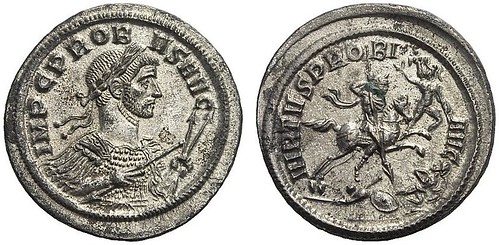
((645 – Probus. Denarius, no year, Ticinum. Probably unpublished. Starting price: 1,200 euros. Hammer price: 12,500 euros.)) Almost as spectacular by its own standards was the hammer price of an extremely rare denarius of Probus on a large, almost medallion-like blank. It shows the fully-armored emperor holding three arrows in his hands. The reverse is devoted to the ‘virtus of emperor Probus’: riding a horse, he throws a lance at an enemy who is already lying on the ground while another one is fleeing; in the background a small figure, perhaps Mars, perhaps Virtus, is greeting the emperor while carrying a trophy on the right shoulder as symbol of victory. This denarius from the 3rd cent. A. D. obtained 12,500 euros which is an incredible price or a coin of this era.
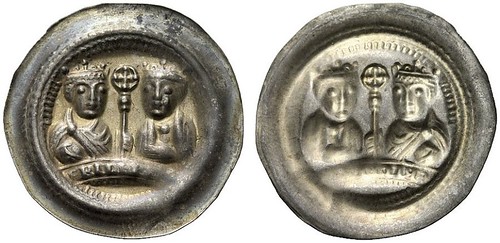
((912 – Gelnhausen (Germany). Frederick I, 1155-1190. Bracteate. Hävernick 49. Extremely fine. Starting price: 3,000 euros. Hammer price: 5,500 euros.)) A beautiful collection of bracteates from the High Middle Ages was hidden amongst the coins of the Holy Roman Empire as a category under which Numismatik Lanz also subsumes Germany. The gorgeous pieces obtained impressive prices, like, for example, a pfennig from Münzenberg that shows Count Kuno beside Frederick I on the obverse (starting price: 3,000 euros / hammer price: 5,600 euros) or a pfennig from Gelnhausen, likewise depicting Frederick I, this time accompanied by his wife Beatrix (starting price: 3,000 euros / hammer price: 5,500 euros).
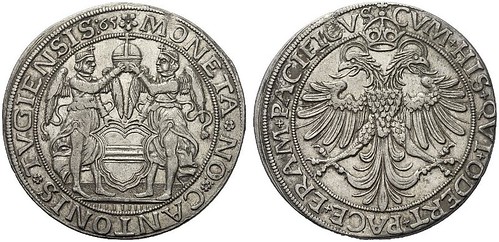
((990 – Zug. Engelthaler 1565. Dav. 8770. Extremely fine. Starting price: 6,000 euros. Hammer price: 12,000 euros.)) Let us end with Switzerland of which some coins with very attractive estimates might have been available if the interest hadn’t been so great. The thaler 1557 from Schaffhausen in very fine started with an estimate of 900 euros and rose to 3,500 euros; the Zurich pfennig of Otto III started at 3,000 euros to be sold for 4,200 euros. The most expensive Swiss coin was an engelthaler from Zug that obtained 12,000 euros and thus doubled its estimate (6,000 euros). You can find all results on the internet at http://www.sixbid.com/browse.html?auction=1046. The next auction sale of Numismatik Lanz will be conducted in December 2014. Consignments are welcome at any time. More information on that are available at Numismatik Lanz, Maximiliansplatz 10, D-80333 Munich, email: info@lanz.com, phone +49 / 89 / 29 90 70, fax: +49 / 89 / 22 07 62. CONFERENCE: CURRENCIES BETWEEN CULTURES
Coin World Editor Steve Roach forwarded this information about a conference in the U.K. where he'll be giving a presentation this week. Good luck!
-Editor
About the Conference: Though money is often characterised as an impersonal medium of exchange, it remains intricately connected to cultural value systems, social relationships, and political regimes. These characteristics are linked to the role of currency as a medium of commensuration designed to render equivalent and transitive once incomparable objects, ideas, signs, and meanings. In this way money goes ‘between’ cultures, and as a medium at the point of contact, money can often become ideologically charged. The eurozone, the rise of alternative currencies like Bitcoin, and the symbolic transformation of currencies during events like the Occupy movement ("We need a Revolution"), indicate that the social, ideological, and political aspects of money remain key modern concerns. This interdisciplinary conference aims to explore the differing ways money has connected, subverted, and entangled different cultures throughout history. Programme: CURRENCIES BEYOND BORDERS 10-10.30am: Globalisation, experimentation and foreshadowing: United States coins in the 1870s Steve Roach, editor in chief of Coin World, Independent Scholar 10.30-11am: Crossing cultural frontiers: when is a Roman coin not a Roman coin? David Wigg-Wolf, Römisch-Germanische Kommission, Frankfurt am Main, Germany 11-11.30am: “One world, one language, one currency”: The Esperantic proposal in 1907 David Astori, Università degli Studi di Parma, Italy 11.30am-12pm: Tea break 12-12.45pm: PLENARY SESSION Capturing a place: A (post-colonial) reading of numismatic iconographic strategies Liv Yarrow, Brooklyn College, CUNY, USA 12.45-1.30pm: Lunch CURRENCIES AND COMMUNICATION 1.30-2pm: Audience targeting and the projection of power in the reign of Nerva Nathan T. Elkins, Baylor University, USA 2-2.30pm: “Stamped all over the king’s head”: defaced pennies and the campaign for women’s suffrage Thomas Hockenhull, Department of Coins and Medals, The British Museum 2.30-2.45pm: Break CULTURAL INTERACTION AND ENTANGLEMENT 2.45-3.15pm: Symbols of interaction: entangled objects as numismatic imagery in ancient Thermae (Sicily) Clare Rowan, The University of Warwick 3.15-3.45pm: Bilingual coins of Severus Alexander: facets of cultural interaction in the Roman provinces Dario Calomino, Department of Coins and Medals, The British Museum 3.45-4pm: Break CURRENCIES AT A TIME OF CHANGE 4-4.30pm: Language, narrative, value: The literary life of silver in seventeenth-century China Sarah E. Kile, The University of Michigan 4.30-5pm: Placing a value on Syria’s past and present cultures: change and continuity on Syrian banknotes under the Al-Assad regime from 1963 to present Rebecca Dodd, Independent Scholar 5pm: Wine Reception Generously supported by the Humanities Research Centre, University of Warwick.
For more information, see:
Currencies between Cultures
(www2.warwick.ac.uk/fac/arts/classics/research/seminars/
THE BOOK BAZARREFORMER MINT DIRECTOR MOY AT BITCOIN EXPO
Former U.S. Mint Director Edmund C. Moy will make the keynote address at the Cryptolina Bitcoin Expo on August 16 in Raleigh, NC. Here's the announcement, which was published July 25, 2014.
-Editor
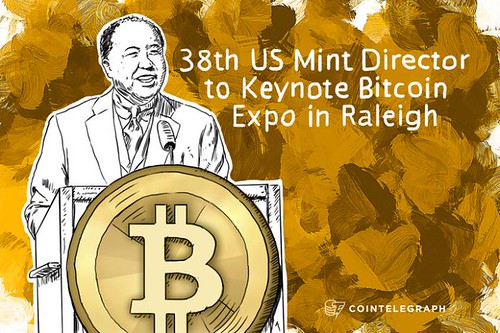
Organizers of the Cryptolina Bitcoin Expo announced today that Edmund C. Moy will be the keynote speaker at a Saturday evening dinner as part of Cryptolina on August 16. Edmund C. Moy was appointed in 2006 by President George W. Bush as the 38th Director of the United States Mint, where Moy served a five-year term until 2011. The Mint Director heads the United States Mint and has several major functions such as advising the U.S. Secretary of the Treasury, working closely with Congress and partnering with the Federal Reserve on forecasting demand, and analyzing payment systems and trends in outlays. Thus, it is very encouraging to see such a high-ranking official with extensive background in finance and payment systems to show support for Bitcoin. Back in May, the CoinTelegraph reported on Moy’s promotion of cryptocurrencies when he responded in a tweet to Credit Suisse having to pay a US$2.6 billion fine for aiding tax evasion saying “It's time banks got competition. Time for cryptocurrencies.” Now, the honorable Mr. Moy will be a keynote speaker at the Carolina’s first Bitcoin Expo, which will be held on August 15-16, 2014. In a press release, Moy explains why he decided to be a keynote speaker at the event and reiterated his favorable stance on Bitcoin. The expo will cover current issues and events pertaining to Bitcoin technologies, startups, crowdfunding, venture capital and angel investment, regulation and more. In addition to a Bitcoin-based business exhibition, there are plans to host nearly two dozen speakers, which will also include Campbell Harvey, PhD Professor of Finance at Duke University, and Elizabeth Ploshay of the Bitcoin Foundation and BitPay. To read the complete article, see: 38th US Mint Director to Keynote Bitcoin Expo in Raleigh (cointelegraph.com/news/111918/38th-us-mint-director-to-keynote-bitcoin-expo-in-raleigh-) For more information on the conference, see: www.cryptolina.com CALIFORNIA MOVES TO LEGALIZE BITCOINS IN STATEDick Johnson writes: California has reversed the trend of eliminating bitcoins by making them legal in the state. What could be the outcome of this in the long run?
Here's an excerpt from an article about the legislation.
-Editor
California Assembly Bill 129, a bill that would deem digital currencies ‘lawful money’ in the US state, will now head to the desk of California Governor Jerry Brown where it will require final approval to become law. The announcement comes just weeks after AB-129 came before the California Senate Banking and Financial Institutions Committee, passing by a 7-1 vote. AB-129, authored by Assembly Member Roger Dickinson, would recognize digital currencies – along with a host of other commonly-issued forms of value including points and coupons – as lawful alternatives to the US dollar. The state-backed currency would still have legal superiority, as Californian residents are not required to accept forms of lawful money. Dickinson recently commented that the law is primarily designed to allow California consumers the ability to continue using a variety of common payment methods, and to remove penalties currently on the books for their usage. AB-129 first gained attention in the digital currency community back in February, when it was reported that the bill had passed the California Assembly, thereby reaching the halfway point in becoming an active law. At the time, representatives from the California Senate Banking and Financial Institutions Committee told CoinDesk AB-129 needed to pass three stages in the Senate before reaching the governor’s desk. These included being approved by the Senate Policy Committee, Senate Fiscal Committee, and finally, the Senate Floor. However, any revisions would necessitate another vote in the Assembly. Records from the California legislature indicate that the Senate passed an amended bill on 19th June by a 7-1 vote. The amended bill then headed back to the Assembly floor for a 23rd June vote, where it passed by a margin of 52-11. Now that is has achieved approval in the Senate and Assembly, Governor Brown will have the final say on whether the bill will become law. To read the complete article, see: California’s Bill to Make Bitcoin ‘Lawful Money’ Heads to Governor (www.coindesk.com/california-bill-bitcoin-lawful-money-heads-to-governor/) CROSS-DRESSER PAYS WITH COUNTERFEIT MONEY
Disguise or lifestyle choice? This story from St. Johns County, FL describes one of the more unusual counterfeit suspects to appear in the news.
-Editor
Last Friday at 7 p.m., the man entered a CVS store on State Road 312 and tried to buy a $300 gift card with three $100 counterfeit bills, deputies said. The clerk discovered the bills were counterfeit and advised the man that they appeared to be fake. The man then fled the area without the gift card or the counterfeit bills, deputies said. The man was described as black and dressed as a woman. He was wearing a tight white shirt with midriff showing and multi-color bottoms, with long black hair and fake eyelashes. To read the complete article, see: Cross-dresser tries to pay with counterfeit money (www.news4jax.com/news/crossdresser-tries-to-pay-with-counterfeit-money/26641812) FEATURED WEB SITE: PORTABLE ANTIQUITIES SCHEMEThis week's Featured Web Site is the Portable Antiquities Scheme.The Portable Antiquities Scheme is a DCMS funded project to encourage the voluntary recording of archaeological objects found by members of the public in England and Wales. Every year many thousands of objects are discovered, many of these by metal-detector users, but also by people whilst out walking, gardening or going about their daily work.

finds.org.uk | |

|

